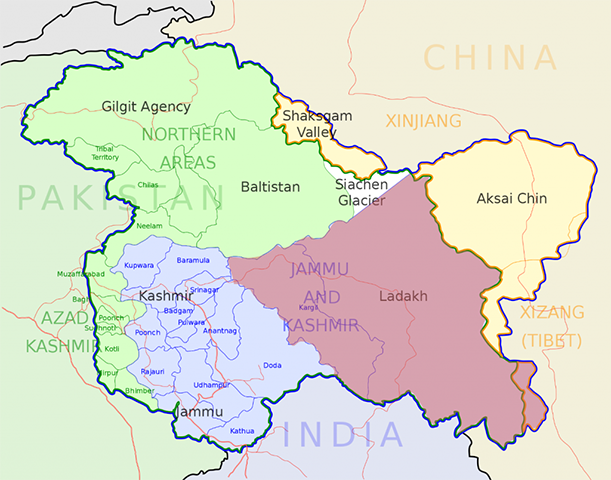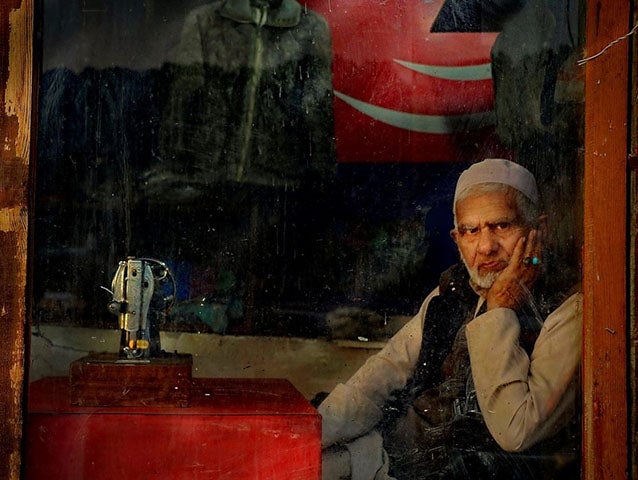Exceptional laboratories: Kashmir, India and the marriage of state and capital
On August 5, 2019, India’s Hindu nationalist government revoked the special autonomous status of Jammu and Kashmir, thus fulfilling its long-held promise of integrating the state with the national mainstream. In doing so, it also stripped the region of statehood itself, dividing it into two union territories—the first comprising Jammu and Kashmir and the second, the region of Ladakh.
Fearing unrest, the government also suspended civil liberties, internet and mobile services in the state, effectively sealing communication within it and from outside. These events can be seen both as an intensification of historical patterns of domination and control as well as a shift in India’s policy.
This article looks at the actions of the Indian state in various sub-regions of the erstwhile state of Jammu and Kashmir over the past year, and how they represent a nexus between a majoritarian state and neoliberal capitalism that curbs dissent through precarity, control and depoliticisation (Svitych, 2019).
Background
Yoked together into a single unit during the colonial period, the state of Jammu and Kashmir comprised five regions with distinct geographies and demographies—Ladakh, Kashmir Valley, Jammu, Azad Kashmir and Gilgit Baltistan. Of these, India controls the first three—Shia Muslim and Buddhist dominated Ladakh, Hindu majority Jammu and lastly, the Muslim majority Kashmir Valley that enjoys a hegemonic position within and outside the state. When the princely state acceded to India in 1947, it was with the promise that the consent of the people would be ascertained. While that did not quite happen, the state was guaranteed limited autonomy in the form of Article 370 of the Indian constitution (Noorani, 2011).
Despite limitations, there was a tacit consensus in the Kashmir valley that the article was a guarantee against external interference and a means of preserving the state’s Muslim majority. Furthermore, it allowed the state to undertake drastic land reforms that dramatically reduced poverty (Suhail, 2018). However, the state’s autonomous character also became a source of contestation outside the Valley. In Hindu-majority Jammu, Article 370 was seen as an impediment to closer integration with the Indian nation and economy. Furthermore, communities such as partition refugees from West Punjab and Valmikis were barred from purchasing land and denied employment opportunities despite their seven-decade long presence. In the Buddhist majority town of Leh (part of Ladakh district), the hegemony enjoyed by Kashmiri political elites caused resentment.

The picture in Ladakh district as a whole however was more complicated because of both the substantial Shia Muslim population and the region’s dependence on Jammu and Srinagar for education and employment. Lastly, the state’s autonomy also hampered the implementation of certain important laws concerning legalisation of homosexuality, and barred state domicile for women marrying outsiders.
However, despite this considerable degree of autonomy, the Indian state has been able to influence politics within the region through legal and political manoeuvrings. Furthermore, the onset of militancy in the 1990s led to parts of the state coming under the Armed Forces Special Powers Act (AFSPA) that offers considerable legal protection to India’s armed forces stationed there (Ranjan 2015). These limitations notwithstanding, Article 370 was successful in giving the state considerable control over land ownership, economy and demographics. Its suspension thus aroused concerns of external interference and recent events indicate how these misgivings were not entirely misplaced.
Patterns of control
Kashmir’s land reforms were a major reason for the improved economic condition of rural Kashmir. One of the region’s main exports is apple, which provides livelihood and income for many farmers. Over the last few years, however, there have been reports regarding dwindling yields across apple orchards and diminishing farm incomes throughout the Valley.
Some farmers have attributed this to the use of a particular insecticide introduced by the government, which they claim have harmed the crops. More seriously, resentment has been brewing against the government’s new procurement process, in which entire batches of apples are downgraded to a lower category (with a lower procurement price), if even a single specimen is found to be substandard.
Such measures increase the arbitrary power of state officials vis-à-vis the farmers. Thus, there is a concern that unchecked bureaucratic control along with deliberate manipulation can severely impact agricultural incomes. In a private interview, a Kashmiri academic argued that these measures were being deliberately introduced to increase precarity among rural youth, eventually forcing them to take employment outside the state. This hypothesis is especially relevant in light of the fact that rural Kashmir was the centre of dissent in the Valley in 2016. In the eyes of locals, therefore, it is not far-fetched to draw a link between manufacturing economic precarity and curbing political opposition.
Another recent controversy concerning the allotment of sand mining contracts to outsiders has also stoked fears of economic domination. As the bids for the contract were to be placed via the internet, local business owners complained of unfair treatment, as they had to struggle with poor internet connectivity owing to government restrictions. However, perhaps the clearest indicator of the government’s intentions has been the changes made to the land laws in October 2020 which has, for the first time, allowed non-residents to purchase property in the state.

Another form of control in rural areas has been through depoliticisation. After putting political leaders under house arrest, the state has tried to supplant traditional leaders by its own appointees. These political appointees, typically occupying the position of the village sarpanch, enjoy a close working relationship with state institutions such as the police and the military.
They also form a part of the state’s surveillance architecture—there have been reports of everyday village conversations being monitored and those expressing critical opinion being questioned by the police or the military. Locals also fear that the new sarpanch system may bring back the days of the Ikhwan, a notorious state-promoted counter-militancy vigilante group blamed for human rights abuses and other excesses (Peer and Ye 2015).
Coupled with the suspension of party politics and a breakdown of communication within the Valley, this emerging form of depoliticisation and surveillance not only indicates deepening control by the Indian state, but also, that the absence of conventional politics may drive more youth towards increasingly violent forms of resistance. Dissatisfaction has also been expressed by some sections of the otherwise pro-India Kashmiri Pandit community, who have complained about lack of efforts to rehabilitate them in the Valley despite being in exile for over three decades.
In contrast to the Valley, the conferment of Union Territory status was greeted with much celebration in the town of Leh, the district capital of Ladakh. Political leaders of the state had long demanded the Union Territory status as a means of delinking themselves from the politics of the Valley. At the same time, significant pockets of the district, most notably the Shia-Muslim stronghold of Kargil, were apprehensive of the new political developments as they feared that this move would deprive them of economic and educational opportunities in Jammu and Kashmir.
Over the last few months, these apprehensions have also been felt in Leh, as locals realise that their region’s status as a union territory is even more stripped down than that of Jammu and Kashmir, which has been provided with limited legislative powers. Ladakh, on the other hand, has found itself completely at the mercy of bureaucrats appointed by New Delhi. While the centre has promised local governance through Hill Councils, this has not translated into much on the ground. Sajjad Kargili, a local politician, explains that the hill councils find the Delhi-appointed bureaucrats indifferent to their concerns and inputs, prompting fears of economic domination, dilution of local culture and environmental degradation. As an ecologically fragile region, there is thus a fear among locals of a ‘one size fits all’ neoliberal developmental agenda. There are also fears that migration from outside could overwhelm both the local economy and culture. This has led to demands for additional constitutional protections for the region.
The fear of economic domination from the outside and bureaucratic interference is also being felt in Jammu, a region which has historically been most supportive of the Indian state. In an interview, Anmol Ohri (a political activist working for the Youth for Jammu organisation) remarked how the suspension of 4G internet has hindered education and employment opportunities. Appeals to the administration have mostly gone unheeded. Furthermore, curbs on local politics have emboldened the bureaucracy to carry out measures such as the demolition of working-class shanty towns and privatisation of highway toll plazas. The mushrooming of these toll plazas at short distances along with steep fares have dampened economic activity.
A more existential threat, however, is faced by the Bakarwal community, consisting of mostly Muslim nomadic herders. A new wave of land acquisition and intimidation tactics by Hindu right-wing groups threatens to displace them from their pastures. As a result, visible signs of dissent have emerged within the region, such as protestors donning the Guy Fawkes (‘Anonymous’) mask as a symbol of protest against the government’s apathy. However, unlike the Valley, the discontent here is still on the grounds of implementation and policy, and not on the deeper question of removal of autonomy.
Conclusion
While the removal of autonomy in August 2019 was unprecedented, it has to be seen within the historical context of New Delhi’s relationship with Jammu and Kashmir and the evolution of India’s political landscape since the advent of economic liberalisation in 1991.
Past governments in New Delhi have arrested Kashmiri political leaders, rigged elections and taken legal measures to dilute state autonomy in practice, if not in theory. Furthermore, the decades-long militancy and the continuous presence of armed forces have resulted in successive generations growing up in a militarised environment. Thus, the removal of autonomy and depoliticisation of the two union territories have eradicated the remaining checks over the central government.
The events in Jammu and Kashmir represent both an example and a precursor of the nexus between majoritarian politics and neoliberal capitalism across India. Over the past few months, the BJP (Bhartiya Janata Party) led government has curbed political dissent and passed laws enabling privatisation of agriculture and loosening of labour regulations in the industry. Furthermore, despite a lockdown that prompted the unplanned migration of more than a 100 million workers from the cities to rural areas, the Indian state has dragged its feet on providing substantive relief to those affected.
This has increased both precarity and unemployment across the country. Thus, in both Kashmir and the rest of India, the events of the past year reflect a consolidation of the neoliberal vision, where the state becomes an enabler of private capital. It also reflects a paucity of imagination, where ‘development’ cannot be conceived outside the confines of capitalism. The state achieves this by placing curbs on democratic politics and by manufacturing precarity.
Viewed from this perspective, it seems that regions such as Jammu and Kashmir are not as much zones of exception as they are the nation-state’s laboratory for testing methods of surveillance, control and domination that can be applied later to the mainland.






